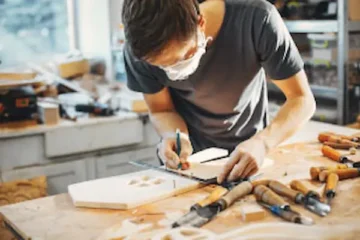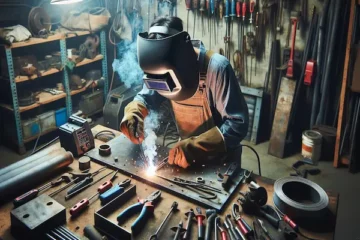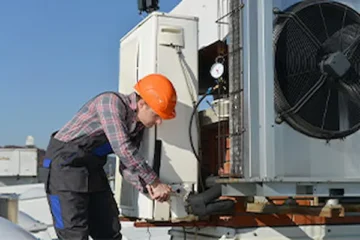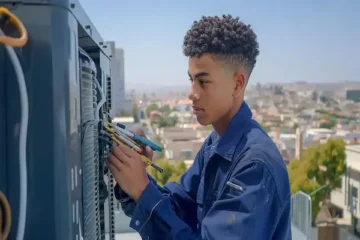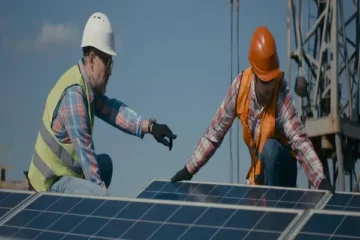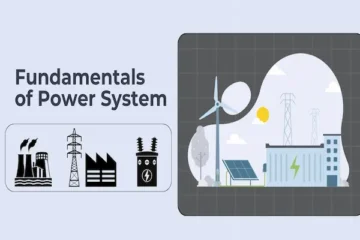Diploma in Plumbing Studies (free to learn)
Free training: home repairs, materials, safety regulations, and career paths.
Anúncios
Practical content, digital certificate, and flexible learning.
Complete Guide to Start Your Career in 2025
Learning plumbing doesn’t have to cost a fortune or require years of formal schooling.
Many free online plumbing courses are available that teach beginners essential skills from basic pipe repair to understanding complex plumbing systems.
These courses cover everything from fixing leaky faucets to reading blueprints and following safety rules.
You can start building plumbing knowledge whether you want to handle home repairs yourself or explore a new career path.
Most beginner courses require no prior experience and let you learn at your own pace.
The skills you gain can save you money on home repairs and open doors to a stable trade career.
Free online plumbing education includes hands-on techniques, system components, and industry standards that professional plumbers use daily.
You’ll discover how plumbing systems work, what tools you need, and how to advance your skills through certification programs that employers recognize.
Overview of Free Online Plumbing Courses
Free online plumbing courses offer accessible training for beginners looking to learn basic plumbing skills. These courses provide flexible learning options and often include certificates upon completion.
Benefits of Learning Plumbing Online
Flexibility and Convenience You can study plumbing online at your own pace. Most courses work on any device, so you can learn from home or anywhere with internet access.
Cost-Effective Training Free online plumbing courses save you money compared to traditional classes. You avoid travel costs and expensive textbooks while still gaining valuable skills.
Practical Skills Development These courses teach you useful DIY skills for home repairs. You learn about pipe installation, basic maintenance, and common plumbing problems. Many courses focus on residential plumbing that homeowners face daily.
Career Exploration Online courses help you explore the plumbing industry before making big commitments. You can see if plumbing interests you without spending money on formal training programs.
How to Choose a Reputable Free Course
Check Course Content Look for courses that cover essential plumbing basics. Good programs include pipe types, tools, safety practices, and common repair techniques. Make sure the content matches your learning goals.
Research the Platform Choose established learning platforms with good reviews. Sites like Alison offer structured courses with clear learning paths. Read what other students say about their experience.
Review Instructor Credentials Check if instructors have real plumbing industry experience. Look for courses taught by licensed plumbers or construction professionals who know current practices.
Examine Course Format Pick courses with videos, written materials, and practice exercises. Interactive content helps you learn better than just reading text.
CPD Accreditation and Certification Options
Understanding Certificates Many free courses offer digital certificates when you finish. An Alison certificate shows you completed the coursework. These certificates work well for personal achievement records.
CPD Accredited Courses Some free online courses have CPD accreditation. This means the course meets professional development standards. CPD accredited courses carry more weight with employers.
Certificate Limitations Free course certificates differ from professional licenses. They show you learned basic skills but don’t replace formal trade certification. You still need proper licensing for professional plumbing work.
Building Your Credentials Use multiple certificates to build your knowledge base. An Alison diploma combines several related courses into one credential. This approach shows employers your commitment to learning.
Fundamentals of Plumbing for Beginners
Understanding plumbing systems starts with learning how water enters your home, flows through fixtures, and exits as waste. You need basic tools like wrenches and pipe cutters, plus safety gear to protect yourself from hazards.
Introduction to Plumbing Systems
Plumbing systems have two main parts that work together in your home. The water supply system brings clean water from the main line into your house. This water flows through pipes to reach faucets, toilets, and appliances.
The drainage system removes wastewater from your home. Used water flows down through drain pipes and out to the sewer or septic system. This system uses gravity to move waste away from your living spaces.
Key System Components:
- Supply pipes (bring water in)
- Drain pipes (take waste out)
- Fixtures (sinks, toilets, tubs)
- Shut-off valves (control water flow)
- Water meter (measures usage)
Supply pipes work under pressure to push water upward to second floors. Drain pipes are larger and slope downward to help waste flow out. Vents allow air into the drainage system so water can flow smoothly.
Most homes connect to city water systems. Rural homes may use wells for water supply and septic tanks for waste removal.
Key Plumbing Tools and Materials
Basic plumbing skills require the right tools for different jobs. Pipe wrenches grip and turn pipes without slipping. Adjustable wrenches work on nuts and fittings of various sizes.
Essential Hand Tools:
- Pipe wrench (10-inch and 14-inch)
- Channel-lock pliers
- Pipe cutter
- Hacksaw
- Screwdrivers (flat and Phillips head)
- Flashlight or headlamp
Common Pipe Materials:
- PVC – white plastic pipes for drains
- Copper – metal pipes for hot and cold water
- PEX – flexible plastic tubing for water supply
You need different fittings to connect pipes together. Elbows change direction, while tees create branches. Couplings join straight pipe sections.
Plumbers also use plumber’s putty and pipe thread compound to seal joints. Teflon tape wraps around threaded connections to prevent leaks.
Plumbing Safety Essentials
Safety comes first when working on any plumbing project. Always shut off the water supply before starting repairs. Find the main shut-off valve for your whole house.
Personal Protection Equipment:
- Safety glasses
- Work gloves
- Knee pads
- Non-slip shoes
Hot water pipes can burn your skin. Let them cool down before touching them. Drain pipes may contain harmful bacteria, so wash your hands after contact.
Electrical Hazards:
- Turn off power near water heaters
- Keep electrical tools away from wet areas
- Use battery-powered lights in damp spaces
Sharp pipe edges can cut you during installation. File down rough edges after cutting pipes. Never force tools or over-tighten fittings, as this can crack pipes or strip threads.
Check for gas lines before digging or drilling. Call your local utility marking service to identify buried pipes. Work in well-lit areas and have someone nearby when doing major repairs.
Components and Structure of Plumbing Systems
Every plumbing system has three main parts that work together: pipes that carry water, fixtures that you use daily, and separate systems for bringing clean water in and taking waste water out. Understanding these basic parts helps you learn how plumbing works in your home.
Pipes and Their Types
Pipes form the backbone of your plumbing system. They carry water throughout your home and remove waste.
Copper pipes are common in older homes. They last a long time and resist corrosion. However, they cost more than other options.
PVC pipes are white plastic pipes used mainly for drainage. They’re cheap and easy to install. You’ll see them under sinks and in basement areas.
PEX pipes are flexible plastic tubes. Many new homes use PEX for water supply lines. They bend around corners without joints.
Galvanized steel pipes appear in very old homes. These pipes rust over time and need replacement. Most plumbers avoid using them today.
Different pipe sizes handle different jobs. Main water lines use larger pipes. Individual fixture lines use smaller ones.
Common Plumbing Fixtures
Plumbing fixtures are the parts of your system you touch and use every day. Each fixture connects to both water supply and drainage systems.
Toilets use the most water in your home. They have a tank, bowl, and internal parts like flappers and fill valves.
Sinks come in kitchen and bathroom types. Kitchen sinks often have garbage disposals. Bathroom sinks connect to pop-up drains.
Showers and bathtubs need both hot and cold water supplies. They use mixing valves to control temperature.
Water heaters store and heat water for your whole house. Tank-style heaters are most common.
Each fixture needs shut-off valves. These valves let you stop water flow for repairs without affecting other areas.
Drainage and Water Supply Systems
Your home has two separate plumbing systems that never mix together.
The water supply system brings clean water into your home. It uses pressure to push water through pipes. Cold water comes directly from the main line. Hot water passes through your water heater first.
Water supply pipes are smaller and use higher pressure. They connect to every fixture that needs clean water.
The drainage system removes waste water and sewage from your home. It uses gravity to move water downward through larger pipes.
Drainage pipes connect to a main sewer line or septic tank. Vent pipes allow air into the drainage system so water flows properly.
P-traps under sinks create water seals. These seals stop sewer gases from entering your home through drains.
Basic Plumbing Skills and Techniques
Most basic plumbing work focuses on three main areas: installing and connecting pipes properly, stopping leaks and making simple repairs, and keeping water and heating systems clean and working well.
Pipe Installation Basics
Learning to install pipes correctly forms the foundation of all plumbing work. You need to understand different pipe materials like PVC, copper, and PEX before starting any project.
Measuring and cutting pipes requires precision. Always measure twice and cut once to avoid waste. Use the right tools for each material – PVC pipe cutters for plastic pipes and pipe cutters or hacksaws for metal pipes.
Joining methods vary by pipe type:
- PVC pipes use primer and cement
- Copper pipes need soldering or compression fittings
- PEX pipes connect with crimp rings or push-fit connectors
You must support pipes properly with hangers and brackets. Space supports every 4 feet for horizontal runs and every 6-8 feet for vertical runs.
Test all connections for leaks before closing up walls. Run water through the system and check each joint carefully.
Fixing Leaks and Minor Repairs
Most household plumbing problems involve leaks that you can fix with basic tools and supplies. Start by turning off the water supply before making any repairs.
Common leak sources include loose fittings, worn gaskets, and cracked pipes. Tighten loose connections with the proper wrench size. Replace rubber gaskets and O-rings when they become hard or cracked.
Pipe repairs depend on the damage size. Small holes can be fixed with pipe repair clamps or epoxy putty. Larger cracks need pipe replacement.
Drain clogs respond to several methods. Try a plunger first for toilet and sink blockages. Use a drain snake for deeper clogs. Avoid harsh chemicals that can damage pipes.
Replace worn faucet parts like washers, cartridges, and valve seats when water drips or flow decreases.
Maintaining Sanitation and Heating
Proper sanitation and heating maintenance prevents health problems and keeps systems running efficiently. Regular upkeep costs less than major repairs.
Water heater care includes flushing the tank yearly to remove sediment buildup. Check the temperature relief valve and replace it if water leaks from the valve.
Set water temperature to 120°F for safety and energy savings. Insulate hot water pipes to reduce heat loss.
Sanitation systems need regular attention. Clean drain traps monthly to prevent odors and clogs. Pour hot water down drains weekly to clear grease buildup.
Check toilet seals and replace wax rings when water appears around the base. Keep vent pipes clear of debris to maintain proper drainage.
Preventive measures include testing water pressure monthly and checking for leaks under sinks and around fixtures. Replace supply lines every 5-7 years before they fail.
Certification, Assessment, and Advancement
Free online plumbing courses offer digital certificates upon completion, with platforms like Alison providing recognized credentials. These certifications help strengthen job applications and demonstrate your commitment to learning plumbing skills.
Completing an Online Plumbing Course
Most free online plumbing courses take 6 to 10 hours to complete. You will watch videos and read written content about pipe installation, leak prevention, and safety rules.
The courses include quizzes throughout the lessons. These help you understand the material better. You must pass these assessments to move forward.
At the end, you take a final assessment. This tests everything you learned in the course. You need to pass this test to earn your certificate.
Course topics typically include:
- Plumbing history and basics
- Copper piping systems
- Reading plumbing blueprints
- Safety regulations
- Leak detection methods
Obtaining Alison and Other Certificates
Alison certificates are digital and arrive as PDF files after you complete the final test. You can print these certificates if you need physical copies.
Alison diploma programs offer more detailed training than basic certificates. These courses cover advanced plumbing topics and take longer to finish.
Other platforms also provide certificates. SkillCat offers accredited courses that lead to certification. Watts provides certificates for water-based industry training.
Certificate requirements:
- Complete all course modules
- Pass quizzes with minimum scores
- Finish final assessment successfully
- Meet attendance requirements for some programs
Leveraging Certifications for Job Applications
Add your plumbing certificates to your résumé under an education or training section. List the course name, provider, and completion date.
Employers value candidates who show initiative in learning. Your certificates prove you have basic plumbing knowledge before starting work.
Include certificates when applying for apprenticeships. Many programs prefer applicants with some background knowledge. This gives you an advantage over other candidates.
Ways to use certificates:
- Attach to job applications
- List on LinkedIn profiles
- Show during interviews
- Include in apprenticeship applications
- Add to trade school applications
Plumbing Career Pathways and Industry Insights
The plumbing industry offers stable employment with clear advancement paths from apprentice to master plumber. Professional networks and continuing education help plumbers stay current with codes and expand their skills throughout their careers.
Starting a Career in the Plumbing Industry
You can enter the plumbing profession through several different paths. Most plumbers start as apprentices after completing basic training.
Common entry routes include:
- Trade school programs (6 months to 2 years)
- Community college courses
- Direct apprenticeships with established plumbers
- Online plumbing courses followed by hands-on training
An apprenticeship typically lasts 4-5 years. You work under a licensed plumber while learning the trade. During this time, you earn money while gaining experience.
After completing your apprenticeship, you can apply for journeyman status. This requires passing a state licensing exam. Requirements vary by state but usually include proof of training hours and work experience.
Master plumber status comes after several years as a journeyman. Master plumbers can run their own businesses and train apprentices. They often earn the highest wages in the plumbing profession.
The plumbing industry offers steady work because people always need water systems and repairs. You can work for plumbing companies, construction firms, or start your own business.
Opportunities for Continued Learning
The plumbing industry constantly evolves with new technologies and building codes. Continuing education keeps your skills current and opens new career opportunities.
Areas for skill development include:
- Green plumbing and water conservation systems
- Smart home technology integration
- Specialized pipe materials and installation methods
- Commercial and industrial plumbing systems
Many states require continuing education credits to maintain your license. These courses cover code updates, safety standards, and new techniques.
Online plumbing courses make it easy to learn new skills on your schedule. You can study advanced topics like hydronic heating or medical gas systems from home.
Some plumbers specialize in specific areas like drain cleaning, pipe lining, or water treatment. These specializations often pay higher rates than general plumbing work.
Professional certifications from manufacturers can boost your earning potential. Companies like Kohler and American Standard offer training on their specific products.
Professional Organizations and Networks
Professional organizations connect you with other plumbers and provide valuable resources for career growth. These groups offer training, certification programs, and networking opportunities.
Key plumbing organizations include:
- Plumbing-Heating-Cooling Contractors Association (PHCC)
- American Society of Plumbing Engineers (ASPE)
- United Association of Journeymen and Apprentices (UA)
Local plumber unions provide job placement, training programs, and collective bargaining power. Union members often receive better benefits and higher wages than non-union workers.
Trade associations offer continuing education courses and keep members updated on industry changes. They also provide business resources for plumbers who want to start their own companies.
Networking events and trade shows let you meet suppliers, contractors, and other professionals. These connections can lead to job opportunities and business partnerships.
Online forums and social media groups connect plumbers across the country. You can ask questions, share experiences, and learn from experienced professionals in the plumbing industry.
